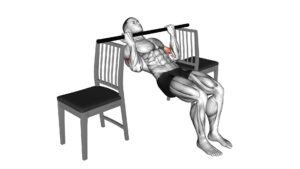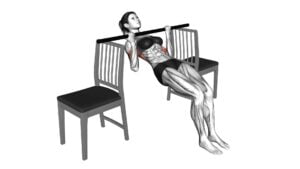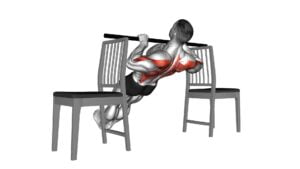Inverted Row With Bent Knee Between Chairs – Video Exercise Guide & Tips

Looking to strengthen your back muscles? The Inverted Row with Bent Knee between Chairs is a great exercise to try. With just two chairs and a few minutes of your time, you can target your back, arms, and core.
Watch This Exercise Video
In this video exercise guide, we'll show you the proper set up, positioning, and step-by-step instructions to perform this exercise correctly. Say goodbye to common mistakes and hello to progress and modification with our helpful tips.
Let's get started!
Key Takeaways
- The inverted row targets multiple muscle groups in the upper body.
- It primarily targets back muscles such as the latissimus dorsi, rhomboids, and trapezius.
- The exercise improves posture and overall upper body strength.
- It engages biceps, forearms, and core muscles.
Benefits of the Inverted Row
Discover the many benefits you can experience by incorporating the inverted row into your workout routine.
The inverted row is a highly effective exercise that targets multiple muscle groups in your upper body. It primarily targets your back muscles, including the latissimus dorsi, rhomboids, and trapezius. These muscles are responsible for pulling movements and help improve your posture and overall upper body strength.
Additionally, the inverted row also engages your biceps, forearms, and even your core muscles. By performing this exercise, you can develop a strong and well-rounded upper body.
One of the great things about the inverted row is that it can be modified to suit different fitness levels. For beginners, you can start with an easier variation by using a higher bar or suspension trainer. This reduces the amount of bodyweight you have to lift and makes it more manageable.
As you progress, you can gradually increase the difficulty by lowering the bar or using a lower suspension point. This increases the amount of bodyweight you have to lift, making the exercise more challenging.
Equipment Needed for the Exercise
To perform the inverted row with bent knee between chairs, you'll need a few pieces of equipment. Here are the essential items you'll need:
- Two sturdy chairs: Make sure the chairs are stable and can support your weight without wobbling or tipping over. You can also use a TRX suspension trainer or a Smith machine as alternatives.
- Yoga mat or towel: Place a mat or towel on the ground beneath the chairs to provide cushioning and prevent slipping.
- Resistance band: Attach a resistance band to the chairs or use a suspension trainer with built-in resistance. This will add extra challenge to the exercise and help increase muscle activation.
- Stopwatch or timer: Use a stopwatch or timer to track your sets and rest periods. This will help you maintain proper workout structure and progression.
- Spotter or training partner: Although not mandatory, having a spotter or training partner can provide assistance and ensure your safety during the exercise.
When performing the inverted row with bent knee between chairs, it's important to take certain precautions and safety measures. Make sure the chairs are positioned securely and don't have any sharp edges or obstacles nearby. Always warm up before starting the exercise to prepare your muscles and joints. Maintain proper form throughout the movement, keeping your back straight and core engaged. Avoid using excessive momentum or swinging your body, as this can lead to injury. If you experience any pain or discomfort, stop the exercise immediately and consult a healthcare professional.
Proper Set up and Positioning
Now let's move on to setting up and positioning yourself properly for the inverted row with bent knee between chairs.
Proper form is crucial to ensure the exercise is effective and safe. To begin, position two chairs parallel to each other, ensuring they're stable and won't move during the exercise. Place your hands on the edges of the chairs, gripping firmly.
Walk your feet forward until your body is at an angle, with your arms fully extended. Bend your knees and cross your ankles. This will be your starting position.
Maintaining proper form is essential to target the correct muscles and prevent injury. Keep your body straight and engage your core throughout the movement. Avoid arching or sagging your back.
As you pull your chest towards the chairs, focus on squeezing your shoulder blades together. Keep your elbows close to your body and exhale as you pull yourself up. Lower yourself back down in a controlled manner, inhaling as you do so. Repeat for the desired number of repetitions.
The inverted row with bent knee between chairs can be modified to suit different fitness levels. Beginners can start with a higher incline, placing their feet on the ground and maintaining a more upright position. As you progress, gradually lower the incline by walking your feet further forward, increasing the difficulty of the exercise.
Advanced individuals can also add weight by wearing a weighted vest or placing a weight plate on their chest. Remember, proper form is crucial regardless of your fitness level, so always prioritize technique over intensity.
Step-By-Step Guide to Performing the Inverted Row
To perform the inverted row with bent knee between chairs, position yourself properly and follow these step-by-step instructions:
- Start by placing two chairs parallel to each other, about shoulder-width apart.
- Sit on the ground between the chairs with your feet flat on the floor and your knees bent.
- Reach behind you and grab the edges of the chairs firmly with an overhand grip.
- Position your body so that your arms are fully extended and your torso is slightly leaning back.
- Engage your core and squeeze your shoulder blades together as you pull your chest up toward the chairs.
The inverted row is a versatile exercise that can be modified to target different muscles and add variety to your workout routine. Some variations of the inverted row include using a barbell, suspension trainer, or resistance bands instead of chairs. This exercise primarily targets the muscles in your upper back, including the rhomboids, trapezius, and latissimus dorsi. It also engages the biceps, forearms, and core muscles for stability.
By following these step-by-step instructions and incorporating variations of the inverted row, you can effectively strengthen your upper body muscles.
Now, let's move on to the next section to learn about common mistakes to avoid when performing this exercise.
Common Mistakes to Avoid
To avoid common mistakes, make sure you're performing the inverted row with bent knee between chairs correctly. Proper form is crucial for maximizing the effectiveness of this exercise and preventing injuries.
One common mistake to avoid is sagging your hips or arching your back during the movement. This can put unnecessary strain on your lower back and reduce the activation of your upper back muscles. To maintain proper form, engage your core and keep your body in a straight line from your head to your heels.
Another mistake to watch out for is rushing through the exercise. It's important to perform each repetition with control and a full range of motion. Avoid using momentum to swing your body up and down. Instead, focus on squeezing your shoulder blades together and pulling your chest towards the chairs.
Lastly, make sure you're using the correct grip. Grab the edges of the chairs firmly and make sure your hands are positioned slightly wider than shoulder-width apart.
Tips for Progressing and Modifying the Exercise
To progress and modify the inverted row with bent knee between chairs, focus on increasing the difficulty and targeting specific muscle groups. Here are some tips for increasing the difficulty and variations of the exercise:
- Increase the height of the chairs: By using taller chairs or elevating the chairs on stable platforms, you can increase the range of motion and make the exercise more challenging.
- Use a weighted vest or backpack: Adding extra weight to your body will increase the resistance and make the exercise more difficult.
- Perform single-arm rows: Instead of using both arms simultaneously, try performing the exercise with one arm at a time. This will require more stability and engage the muscles in a different way.
- Elevate your feet: By placing your feet on an elevated surface, such as a bench or step, you can increase the difficulty and target your upper back muscles even more.
- Use a suspension trainer: Instead of using chairs, you can use a suspension trainer like TRX to perform inverted rows. This will challenge your stability and provide a different stimulus to your muscles.
Frequently Asked Questions
How Many Sets and Reps Should I Do for the Inverted Row Exercise?
For the inverted row exercise, the optimal rep range depends on your fitness level and goals. Generally, it's recommended to start with 3 sets of 8-12 reps.
As you progress, you can increase the number of sets or reps. To make the exercise more challenging, you can try variations like using a straight bar or adding weight.
Remember to maintain proper form and gradually increase the intensity for better results.
Can I Do the Inverted Row Exercise if I Have Shoulder or Back Pain?
If you have shoulder or back pain, it's important to be cautious when doing the inverted row exercise. It can put stress on those areas.
Instead, focus on exercises that improve shoulder mobility and strengthen your back without causing pain. Some alternatives include seated rows, lat pulldowns, or band pull-aparts.
Remember to consult with a healthcare professional before starting any new exercise routine, especially if you have existing shoulder or back issues.
Is It Necessary to Warm up Before Performing the Inverted Row Exercise?
Before performing the inverted row exercise, it's important to warm up. Warming up helps to prepare your muscles and joints for the workout ahead, reducing the risk of injury. It also increases blood flow and oxygen delivery to the muscles, improving their performance.
Additionally, proper form is crucial in the inverted row exercise. By warming up and focusing on your form, you can maximize the benefits of this exercise and minimize the risk of strain or discomfort.
Can I Do the Inverted Row Exercise at Home Without Chairs?
Yes, you can definitely do the inverted row exercise at home without chairs.
There are alternative equipment and modifications that you can use.
For example, you can use a sturdy table or a bar attached to a doorframe as a substitute for the chairs.
Additionally, you can also modify the exercise by using a resistance band or performing bodyweight rows.
These modifications will allow you to still target your back muscles effectively while working out at home.
How Long Does It Take to See Results From Doing the Inverted Row Exercise Regularly?
Regularly performing the inverted row exercise can yield results, but the timeline may vary.
It's essential to focus not just on the exercise itself, but also on optimal nutrition for maximizing results.
Avoid common mistakes like using improper form, not engaging your core, or neglecting to progress in difficulty.
Consistency is key, so stick with it and be patient.
With dedication and proper technique, you should start seeing improvements in strength, muscle tone, and overall fitness.
Conclusion
In conclusion, the inverted row with bent knees between chairs is a highly beneficial exercise that can be done with minimal equipment.
By following the proper set up and positioning, as well as the step-by-step guide, you can effectively perform this exercise.
Avoiding common mistakes and utilizing tips for progression and modification will help you make the most out of this exercise and achieve your fitness goals.

Author
Years ago, the spark of my life’s passion ignited in my mind the moment I stepped into the local gym for the first time. The inaugural bead of perspiration, the initial endeavor, the very first surge of endorphins, and a sense of pride that washed over me post-workout marked the beginning of my deep-seated interest in strength sports, fitness, and sports nutrition. This very curiosity blossomed rapidly into a profound fascination, propelling me to earn a Master’s degree in Physical Education from the Academy of Physical Education in Krakow, followed by a Sports Manager diploma from the Jagiellonian University. My journey of growth led me to gain more specialized qualifications, such as being a certified personal trainer with a focus on sports dietetics, a lifeguard, and an instructor for wellness and corrective gymnastics. Theoretical knowledge paired seamlessly with practical experience, reinforcing my belief that the transformation of individuals under my guidance was also a reflection of my personal growth. This belief holds true even today. Each day, I strive to push the boundaries and explore new realms. These realms gently elevate me to greater heights. The unique combination of passion for my field and the continuous quest for growth fuels my drive to break new ground.







